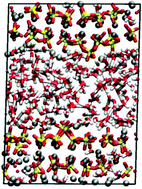Effects of elevated temperature on the structure and properties of calcium–silicate–hydrate gels: the role of confined water
Abstract
The binding phase of cementitious materials, calcium–silicate–

* Corresponding authors
a
Massachusetts Institute of Technology, Department of Materials Science and Engineering, 77 Massachusetts Ave., Cambridge, MA 02139-4307, USA
E-mail:
krystyn@mit.edu
b Inspur Group, State Key Laboratory of High-end Server & Storage Technology, Jinan, Shangdong, P.R. China
The binding phase of cementitious materials, calcium–silicate–

 Please wait while we load your content...
Something went wrong. Try again?
Please wait while we load your content...
Something went wrong. Try again?
P. A. Bonnaud, Q. Ji and K. J. Van Vliet, Soft Matter, 2013, 9, 6418 DOI: 10.1039/C3SM50975C
To request permission to reproduce material from this article, please go to the Copyright Clearance Center request page.
If you are an author contributing to an RSC publication, you do not need to request permission provided correct acknowledgement is given.
If you are the author of this article, you do not need to request permission to reproduce figures and diagrams provided correct acknowledgement is given. If you want to reproduce the whole article in a third-party publication (excluding your thesis/dissertation for which permission is not required) please go to the Copyright Clearance Center request page.
Read more about how to correctly acknowledge RSC content.
 Fetching data from CrossRef.
Fetching data from CrossRef.
This may take some time to load.
Loading related content
